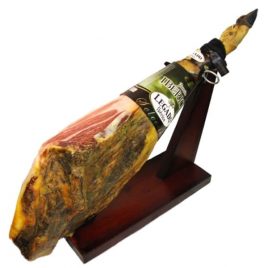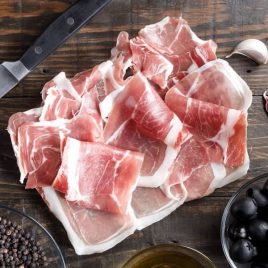Spanish ham
Showing all 2 results

Iberico Ham
The black Iberian pig lives primarily in the central and southwestern region of the Iberian Peninsula, which includes both Portugal and Spain.
Immediately after weaning, the piglets are fattened on barley and maize for several weeks. The pigs are then allowed to roam in pasture and oak groves to feed naturally on grass, herbs, acorns, chestnuts, and roots, until the slaughtering time approaches. At that point, the diet may be strictly limited to olives, chestnuts or acorns for the best quality jamón ibérico, or may be a mix of acorns and commercial feed for lesser qualities.
The hams from the slaughtered pigs are salted and left to begin drying for two weeks, after which they are rinsed and left to dry for another four to six weeks. The curing process then takes at least twelve months, although some producers cure their jamones ibéricos for up to 48 months.
In particular, the ibérico hams from the towns of Guijuelo in the Salamanca province and Jabugo in the Huelva province have their own denominación de origen.
The hams are labelled according to the pigs' diet and the percentage of the pigs' Iberian ancestry, with an acorn diet and pure-bred Iberians being most desirable. The current labelling system, based on a series of color-coded labels, was phased in starting in January 2014.
- The finest is called jamón ibérico de bellota (acorn). This ham is from free-range pigs that roam oak forests (called dehesas) along the border between Spain and Portugal and eat only acorns during this last period
- The exercise and diet have a significant effect on the flavour of the meat; the ham is cured for 36 months. This grade is divided into black-label jamón 100% ibérico de bellota, produced from pure-bred Iberian pigs, and red-label jamón ibérico de bellota from free-range pigs that are not pure-bred.
- The next grade is called jamón ibérico cebo de campo. This ham is from pigs that are pastured and fed a combination of acorns and grain.
- The third type is called jamón ibérico de cebo, or simply, jamón ibérico it is cured for 24 months and is the most popular due to its cheaper prices and shorter curing time. This ham is from pigs that are fed only grain.

Serrano Ham
The majority of Serrano Jamones are made from a landrace breed of white pigs or from commercial breeds such as Duroc or Berkshire are not to be confused with the often more expensive jamón ibérico, made from black Iberian pigs.
These aged hams were known as a delicacy even in the days of the Roman Empire. The protein is of high quality and after curing for 12-14 months the meat becomes a rich intense red colour.
The serrano leg is always bigger than the Ibérico as it always contains less fat due to the different diets of each pig breed. Unlike the Italian prosciutto which is cured cold, the Spanish Jamones (ibérico & serrano) are cured in a specially ventilated room that mimics the conditions of the traditional cellar.
Jamón serrano can be used in a charcuterie board, in a bocadillo (crunchy bread roll), salad, stews, croquettes, pasta, pizza just about wherever your culinary imagination can take you.
Download our info sheet

